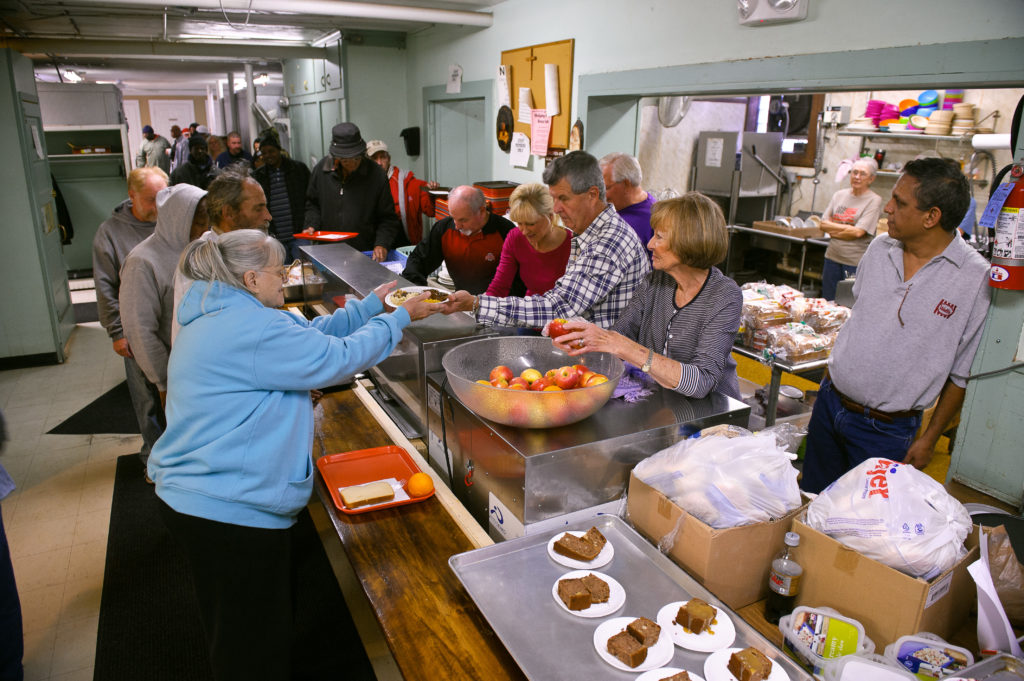
Poverty and hunger can seem like insurmountable issues. It’s easy to dismiss them entirely on the notion that there is little one person can do. Thankfully, we have people throughout world history that have taught us to start small.
Locally, we have people like the late Rev. Robert Armstrong, a priest from the former St. Louis Parish in East Toledo who in 1981 started the Helping Hands of St. Louis Outreach Center.
“We’re trying to put a dent in poverty,” said Paul Cook, director. “We try to do the best with what we have.”
Helping Hands is perhaps best known for serving hundreds of meals every day in East Toledo, though it also has a popular food pantry, clothing center and hygiene kit distribution program.
The parish of St. Louis was closed by the diocese in 2005, but its outreach ministry remains alive and well. Helping Hands has always served the needs of the East Side and beyond, formally becoming part of Catholic Charities in 2011.
“Before Catholic Charities, we did everything ourselves,” Cook said. “Now, they take care of a lot for us, because we only have three and a half staff members, so they handle the budgeting, paperwork and things like that.”
That allows Cook and a whole lot of volunteers — roughly 28 core groups from churches and nonprofits from around Northwest Ohio — to pitch together and serve the needs of citizens. Neither services nor volunteering opportunities are limited to Catholics, as there are several other religions involved.
Even the grocery distribution can be a collaboration of sorts, working with other pantries in the area when certain supplies are in overabundance. Helping Hands serves around 100 breakfasts and 375 lunches, sometimes many more, every single weekday.
“It just makes us feel like a part of something,” said Debbie Gaster, who with husband Larry, comes from St. Joseph Parish in Sylvania about once a month. “We’ve been very blessed and fortunate, so it’s something small we can do.”
Volunteers seem to spike at the holidays, when Cook noted that “it’s a feel good time,” but the center has a dedicated group of people who assist year round. The help is needed, because Cook says demand is strong and he doesn’t see things getting better.
“Right now no, not until the jobs pick up,” Cook said. “We have some people with felonies, and not until people take a chance on them. Some people simply can’t work because they have some kind of physical or mental illness. About 3-4 percent of our people can’t read or write.”
Cook noted that he has patrons from not only East Toledo, but many from the north, south and west, too. Often he finds they ride a bus, get a ride, or even walk very long distances to take advantage of what Helping Hands offers.
The clothing store is open two days a week, and anyone may to shop for their needs just as they would in a department store.
The food pantry operates in similar fashion. Anyone can take advantage of the services, but the hygiene kit distribution is partially grant-funded, so recipients must be from the East Side.
Helping Hands serves about 70,000 on-site meals, distributes 2,400 bags of groceries and 650 hygiene kits every year. While the group relies heavily on donations, it also receives federal grants, though those dollar amounts decrease every year.
There are several other outreach centers that offer meals and assistance, but if Helping Hands weren’t around, it makes Cook wonder where everyone would go for help.
“I really don’t know,” Cook said. “I hate to think what would happen.”






















